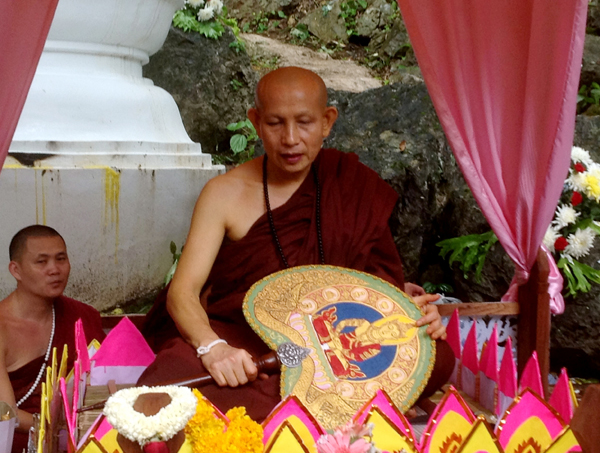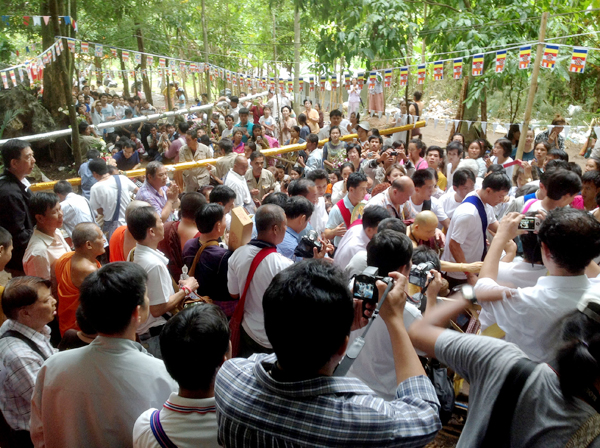Today, communication plays a vital role in all aspects of human life. With the help of modern technology, people upgrade their way of communication with the world. Ironically, it is unusual for an individual Buddhist monk, who undertook a vow of intensive meditation in solitude, a form of non-communication with outside world for 3 years, 3 months and 3 days in a cave on a high mountain ranges in Lampang, northern Thailand.
This vow taking has officially concluded on July 20, predawn at 03.33 am local time. On March 19, 2010, some 3 years ago, Khruba Bonchum had made a decision to complete practicing meditation in the Rajagriha cave in Ngao district, Lampang, a 20-km distant from Lampang-Ngao highway for a quarter and 3 years.

This particular individual Buddhist monk is widely known as Khruba Bonchum in the greater Mekong region, where Shan State, Laos, Thailand and Sipsongpanna (Xixuangbanna) Prefecture of China meet, who was officially ordained in the Thai Sangha Order as Nyanasamvaro.
Khruba Bonchum follows the Northern Thai Forest monk tradition which dates back to early 19th century Khruba Sriwichai (Sirivijaya), who was well-known as an activist against the centralization of Thai Sangha homogeneity.
On this particular day, tens of thousands of devotees from near and afar, virtually from all corners have gathered here on the mountain range in Ngao district, as they have been waiting for this event to occur for ages. Before the clock turns the tick at 03:30:03 on July 20 early morning, people from all walks of life and nationals without discrimination have come together, gathering themselves in front of the Rajagriha cave holding their breaths while waiting.
Khruba may have started the first step from his seating meditation exactly at the specific time. People were amazed by seeing through the cave from distance when Khruba emerges with a candle-lit light and some of his helpers spotting flash light. “Khruba Paw Sintham Bonchum is really coming out…” some shouted in a low tone from the crowds.
We all are seeing Khruba is actually coming out and approaching toward the crowds. He arrives at the front panel where he greets the devotees around 3.50. As soon as his arrival on a specially prepared seat, Khruba kneels down to lead all the people to pay homage to the Buddha.
A series of prayers and a brief silent meditation also followed.
Then, Khruba administered the Five Precepts (Pali: Pañcasīla) following a request for a forgiveness as always happens in any Buddhist ceremonial event.
Khruba greets the devotees with a sermon in Shan: “Human may expose their appearance in many different ways in order to show themselves as ‘good’. But you cannot just judge by their appearance alone. Whether one’s appearance is a monk, a lay devotee, or any other kinds, they may be good or bad.”
For whatever reason you do either good or bad, we all have to face two kinds of vicissitudes: praise and blame.
The scenario seen on this mountain range are tens of thousands of people who gather around as if they were on pilgrimage. The ceremonies in which to honor and welcome Khruba take place for two days: one on July 20 and the other on 21. The first is to welcome Khruba Bonchum breaking his last moment of non-communication meditation in solitude and the next is to renew ‘life extension’ according to northern Thai tradition.

Communities who gathered here include Thai, Laotian, Bhutanese, Taiwanese, Singaporean, Korean, Japanese, Chinese, Yao, Palaung, Burmese, Shan and many other ethnics and nationalities with a single aim, to receive a “blessing” from Khruba. This event although a Buddhist one, some other religious believers also have come to visit and paying respect. It is a true transnational communal gathering which is unusual and amazing meeting of people around the world. Khruba Bonchum’s dharmic power has indeed touched upon across all the differences and national boundaries.
Some people have come to the Rajagriha Cave, Ban Mae Kae Patthana, Mae On, in Ngao district, Lampang, since a week before the actual ceremonial event is taking place. The 2-day events make a heartfelt and emotional for some participants as they meet Khruba Bonchum for the first time since over 3 years. It takes them a long way to come here, especially for the Shan devotees who have to cross the Thai-Burma border or on an official way which measures one's financial well-being. Without a true trust, devotion and belief in Khruba, they would not make this hard journey to this Ngao mountain range.
“I don’t know how to describe my feeling as seeing Saokhuva, who has sustained by only eating fruits during 3 years and 3 months while practicing meditation; I feel sympathetic joy. I can’t maintain not to let my tears come out,” said Kham Hsen, a young lady who runs a Mini Mart from Namkham, on Sino-Burma border town.
Sai Noan, a native of Kengtung, Shan State, said his group have come here since on July 5, and was among the first who has arrived at the mountain cave.
“We were the first to come here; only two days later other groups have arrived in. We were preparing the seat where Khruba Bonchum would come to pray and give the sermon, and other decoration along the way,” said Sai Noan.
The teachings
“Everyone is subject to grow old, suffer from disease and finally dead. Khruba is also no exception. No one is above this natural law. So, try to be morally good and practice dharma if one wants to stand above all else.”
Throughout the events, there is no worry for the place to live nor food for energizing one's sustainability. Everybody will be served by helping one another and by way of donation.
“People who do good things or practice dharma honestly may live anywhere, but people who do bad things (although they may live in a palace) may not live well,” said Khruba quoting his sermon.
During a period of over 3 years, Khruba Bonchum has been living with a 3-member cobra’s family. The cobra king has 2 wives, but not so long ago, one of the wives died.
There are also 28 dogs; they would come and go around the cave. Khruba would feed them time to time as they were the main security force protecting him.
“Animals are indeed very honest compared to men. They don’t cheat or push around the bush,” Khruba told the crowds.
Following his sermon and a brief meditation at his desanasana (‘preaching seat’), Khruba Bonchum walked around where people especially lady devotees were anxiously standing in waiting. Then, Khruba Bonchum entered to the fourth gate way to the cave for retirement and later for cutting hairs and bathing.
Khruba’s advice is to live one's life by being honest, vigilant and diligent.
Announcing of 'sainthood'
In the afternoon session of July 21, Khruba made a special announcement on his spiritual achievement: “To be honest, I have archived a higher level of attainment in the Buddhist practice. This is not a 'boasting' at all,” quoting the afternoon session of Khruba Bonchum's sermon in Shan language. The crowds responded with cheers “sadhu” three times.
Criticism
Khruba has come under criticism when his photos of long hairs were spread on social media networks in which some Buddhists see inappropriate as a Theravada Buddhist tradition. “I have never seen or known about such appearance or practice in Theravada tradition in my life time,” comments Soe Naing, 47, based in Japan, in response to the long hair photos of Khruba on a facebook account. But many facebook users also commented Khruba followers firing back at him for his ignorance.
Ven. Dr. Khammai Dhammasami, an Oxford based Shan Buddhist scholar, opines that Khruba takes the meditation on the loathsomeness of the body seriously and meditates daily on the repulsive nature of the body, including hairs. He does not care how he looks; he only contemplates on the impermanent nature of the whole body i.e. nāma-rupaṃ aniccaṃ etc.
“Khruba Bonchum has always kept his hairs uncut in the cave since the first time he started cave meditation in his early teens. Usually he keeps them for three to four months. But this is the first time he has done a long meditation over three years. So, it is long,” Ven. Dhammasami’s email to his dharma friends has been quoted as saying.
Khruba Bonchum is known to have possessed many virtues, higher spiritual qualities and linguistic skills in which he learns through meditation. He has been ardently working hard to achieve Buddhist higher ‘perfection’ (Pali: Pāramitā) through performing many good deeds, building up many Buddhist temples and stupas across golden triangle region and mental purification. Among the many temples he has built, Wat Phrathat Sri Donreung located at Mongphong, Tachileik Township in Shan State, opposite Mae Sai, Thailand, appears to be Khruba’s favorite. It is from this place that earned him ‘Saokhuva Vunchum Mongphong’ among the Shan devotees or ‘Mongphong Sayadaw’ among the Burmese.
Due to the nature of his transnational movements, charismatic leadership and outspokenness, while political tension reached its peak in Shan State during 2005, Khruba Bonchum was forced to abandon the Mongphong center and barred from re-entering Shan State up to the present. However, Khruba Sengla, the chief Sangha Nayaka administrator in Tachileik and Myanmar government delegate headed by U Hsan Sint, minister of Religious Affairs from Naypyitaw have been witnessed during Khruba appearance from the cave on July 20-21 separately, a Burmese traditional physician, who runs an ayurvedic clinic in Kengtung, has been quoted as saying.


